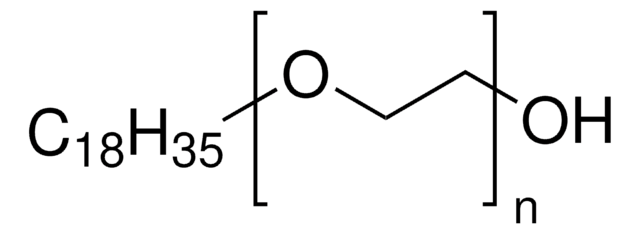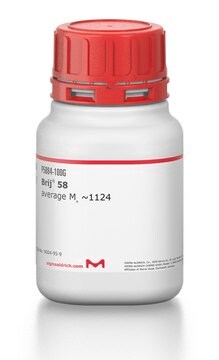STS0214
ECO BRIJ® O20
average Mn ~1,150
Synonym(s):
BRIJ® O20, Polyoxyethylene (20) oleyl ether
About This Item
Recommended Products
description
non-ionic
Quality Level
form
solid
mol wt
average Mn ~1,150
greener alternative product characteristics
Use of Renewable Feedstocks
Design for Degradation
Learn more about the Principles of Green Chemistry.
sustainability
Greener Alternative Product
mp
25-30 °C (lit.)
hydroxyl value
50‑65 mg KOH/g
solubility
water: soluble 1 g/L at 20 °C
density
0.901 g/cm3 at 20 °C
HLB
15.5
greener alternative category
InChI
1S/C20H40O2/c1-2-3-4-5-6-7-8-9-10-11-12-13-14-15-16-17-19-22-20-18-21/h9-10,21H,2-8,11-20H2,1H3/b10-9-
InChI key
KWVPFECTOKLOBL-KTKRTIGZSA-N
Looking for similar products? Visit Product Comparison Guide
General description
Features and Benefits
- 100 % Renewable
- 100 % Bio-based
- Certified to the USDA BioPreferred Program
- Lower carbon footprint than petrochemical-based versions
- High-purity chemical suitable for a wide variety of research applications
Other Notes
Legal Information
Signal Word
Warning
Hazard Statements
Precautionary Statements
Hazard Classifications
Aquatic Chronic 2 - Skin Irrit. 2
Storage Class Code
11 - Combustible Solids
WGK
WGK 1
Flash Point(F)
>464.0 °F - Equilibrium method
Flash Point(C)
> 240 °C - Equilibrium method
Choose from one of the most recent versions:
Certificates of Analysis (COA)
Sorry, we don't have COAs for this product available online at this time.
If you need assistance, please contact Customer Support.
Already Own This Product?
Find documentation for the products that you have recently purchased in the Document Library.
Our team of scientists has experience in all areas of research including Life Science, Material Science, Chemical Synthesis, Chromatography, Analytical and many others.
Contact Technical Service




